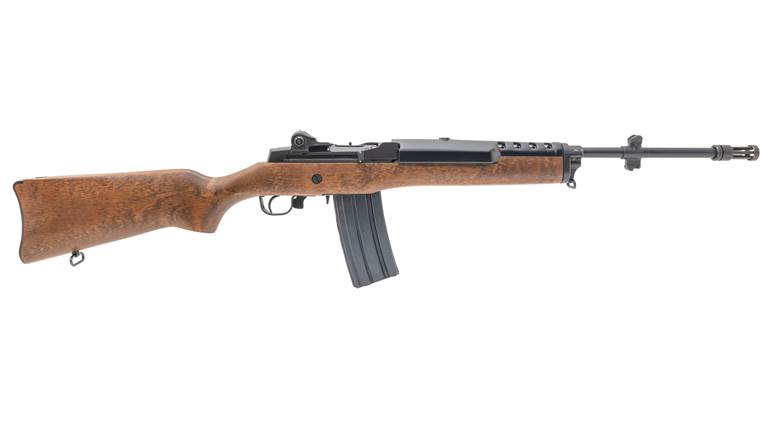
Even though rifles had been around for at least a couple hundred years, because of their expense and the skill needed in their employment, by the late 18th century the simpler smoothbore musket remained the principal infantry arm.
Due to experiences in the American War of Independence, the British gained more respect for rifled arms and, for a time during the Revolution, even experimented with a corps of riflemen armed with an interesting breech-loading rifle designed by Maj. Patrick Ferguson, who also led the unit.
English interest in and experimentation with rifles continued apace and, spurred on by conflicts with France, authorities decided to raise special, permanent regiments armed with rifled arms.
Though a number of guns were tried, it was ultimately decided to adopt the design of London gunmaker Ezekiel Baker. Taking its basic appearance from Germanic jäger-style rifles, Baker’s arm had a 0.625" “carbine” bore rifled with seven grooves at a twist of one turn in 120".
Mounting a 30½" barrel, the “Infantry Rifle,” as it was officially termed, was considerably shorter than the 39"-barreled India Pattern “Brown Bess” musket of the period. The “Baker,” as is it is more commonly known, was full-stocked, employed a hooked breech, mounted brass furniture (to include a butt box that contained assorted tools) and incorporated a sporting-style cheekpiece.
A brass-handled sword bayonet with a 23" blade could be affixed to the rifle via a sturdy bar sited on the right side of the muzzle. A rear, two-leaf folding sight was standard.
Initially designed to have balls hammered down the bore, this loading method was determined to be impractical in the field and was replaced with patched balls, linen (or in some cases leather) patches being actually attached to the bullets. The Baker was loaded by means of a horn with an integral measure. Initially riflemen were given separate priming flasks, though these eventually fell into disfavor. Soldiers also were equipped with cartridges and loose bullets so the Baker could be more rapidly loaded—musket-fashion—should the need arise. The standard powder charge was around 100 grs. of fine rifle powder which had a granulation between modern FFFg and FFFFg.
There were different versions of the Baker (including carbines), and probably the most common is seen here—the Pattern 1805. Baker rifles were famously issued to the 60th and 95th Rifles (the latter regiment’s exploits popularly depicted in Bernard Cornwell’s “Sharpe’s” series of novels and C.S. Forester’s Rifleman Dodd) but they also saw use with other units including Portuguese Caçadores and part of The King’s German Legion.

Cocks were of the sturdy reinforced ring-neck style, and lockplates normally marked with a king’s crown surmounting “GR”—Georgius Rex, for King George III—as well as “TOWER” where the guns were set up. Privately purchased Bakers, carried by local militia, would usually display only a maker’s name.
The Baker rifle was a highly regarded arm, augustly being considered a specialist’s gun. Individuals recruited into rifle regiments were usually more skilled and of higher intelligence than regular line infantrymen, who were issued smoothbore muskets.
The Baker undoubtedly had its greatest period of glory during the Napoleonic Wars, but it continued as an item of issue into the 1830s when it was replaced by the percussion Brunswick rifle. Many Bakers were sold as surplus, most notably to Mexico, which employed them at the Alamo and during the Mexican-American War.
In 1815, 2,000 Pattern 1805s were modified to accept a unique triangular socket bayonet by removing the sword bar, trimming back the stock and adding a small under-barrel lug. It is such an arm that we see here. This particular example, which turned up in Argentina, is in superb condition, exhibiting much original color case-hardening and virtually all of the browned finish on the twist barrel. The bore is unblemished. The stock is stamped with a storekeeper’s mark dated 1806. These rifles, in any shape, are highly desirable collector’s pieces and, accordingly, one in this condition and configuration is easily worth $10,000.
Gun: Pattern 1805/15 Baker rifle
Manufacturer: Tower/contractors
Caliber: .625
Manufactured: 1806
Condition: NRA Excellent (Antique Gun Standards)
Value: $10,000






















![Winchester Comm[94]](/media/1mleusmd/winchester-comm-94.jpg?anchor=center&mode=crop&width=770&height=430&rnd=134090756537800000&quality=60)
![Winchester Comm[94]](/media/1mleusmd/winchester-comm-94.jpg?anchor=center&mode=crop&width=150&height=150&rnd=134090756537800000&quality=60)











